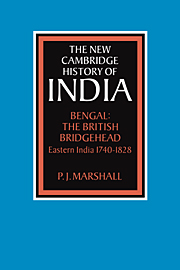Book contents
- Frontmatter
- 1 The setting for empire
- 2 Late Mughal Bengal
- 3 The crisis of empire, 1740–65
- 4 The new regime
- 5 A new society?
- 6 Conclusion
- Bibliographical Essay
- Index
- THE CAMBRIDGE HISTORY OF INDIA
- Map 1 Eastern India, 1740–1828: places mentioned in the text
- Map 2 Eastern India, 1740–1828: economic
- Plate Section">
- References
3 - The crisis of empire, 1740–65
Published online by Cambridge University Press: 28 March 2008
- Frontmatter
- 1 The setting for empire
- 2 Late Mughal Bengal
- 3 The crisis of empire, 1740–65
- 4 The new regime
- 5 A new society?
- 6 Conclusion
- Bibliographical Essay
- Index
- THE CAMBRIDGE HISTORY OF INDIA
- Map 1 Eastern India, 1740–1828: places mentioned in the text
- Map 2 Eastern India, 1740–1828: economic
- Plate Section">
- References
Summary
Alivardi Khan's successful usurpation of the throne of Bengal encouraged others to try to establish claims to Bengal's wealth. Most could rely on some degree of endorsement by the Mughal Emperors, who hoped to increase the flow of tribute. The Marathas were the earliest and the most dangerous contenders.
By 1740 a successful northward drive by the Marathas had enabled them to conquer most of central India. In the process the overall control of the Peshwas, or chief ministers, had weakened, allowing various leaders to carve out what amounted to their own independent territories. Beyond their own domains they were pushing their influence further, collecting chauth, forced contributions, from areas which they could dominate. The north-eastern arm of the Maratha drive had enabled one of their leaders, Raghuji Bhonsla, to subjugate Berar and to establish his base around Nagpur. From Berar Maratha troops could be sent into either Bihar or Orissa. Fearful that the new Peshwa of the Marathas, Balaji Rao, would try to establish a claim to Bengal first, and given encouragement by the family of Sarfaraz Khan, whom Alivardi Khan had deposed, Raghuji Bhonsla sent his army through Orissa and into western Bengal in 1742. Raiding parties of the Maratha cavalry plundered the area west of the Hooghly up to Murshidabad.
Keywords
- Type
- Chapter
- Information
- Bengal: The British BridgeheadEastern India 1740–1828, pp. 70 - 92Publisher: Cambridge University PressPrint publication year: 1988



